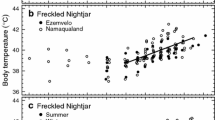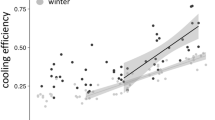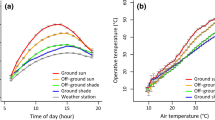Abstract
Much recent work on avian physiological adaptation to desert environments has focused on larks (Passeriformes: Alaudidae). We tested the prediction that the threatened red lark (Calendulauda burra), a species restricted to very arid parts of South Africa and which is not known to drink, exhibits highly efficient evaporative cooling and makes pronounced use of facultative hyperthermia when exposed to high air temperatures (Ta). We also predicted that C. burra possesses similarly low basal metabolic rate (BMR) and total evaporative water loss (EWL) at moderate Ta as reported for species from the deserts of the Middle East. Rest-phase thermoregulation in C. burra was characterized by an unusually low lower critical limit of thermoneutrality at Ta = ~ 21 °C and a BMR of 0.317 ± 0.047 W, the lowest BMR relative to allometrically-expected values yet reported in any lark. During the diurnal active phase, red larks were able to tolerate Ta up to 50 °C, with the onset of panting occurring at Ta = 38 °C. Maximum EWL was 1.475 ± 0.107 g h− 1 at Ta = 50 °C, equivalent to 620% of minimum EWL at thermoneutrality. The maximum ratio of evaporative heat dissipation to metabolic heat production was 1.58, a value towards the lower end of the range reported for passerines. Our data support the prediction that C. burra shows metabolic traits similar to those of other larks inhabiting extremely arid climates, but not the notion that evaporative cooling at high Ta in this species is more efficient than in most passerines.






Similar content being viewed by others
Abbreviations
- EWL:
-
Evaporative water loss
- BMR:
-
Basal metabolic rate
- RMR:
-
Resting metabolic rate
- EHL:
-
Evaporative heat loss
- MHP:
-
Metabolic heat production
- M b :
-
Body mass
- T a :
-
Air temperature
- T b :
-
Body temperature
- T lc :
-
Lower critical limit of thermoneutrality
- T uc :
-
Upper critical limit of thermoneutrality
References
Alström P, Barnes KN, Olsson U, Barker FK, Bloomer P, Khan AA, Qureshi MA, Guillaumet A, Crochet P-A, Ryan PG (2013) Multilocus phylogeny of the avian family Alaudidae (larks) reveals complex morphological evolution, non-monophyletic genera and hidden species diversity. Mol Phylogenetics Evol 69(3):1043–1056
Aschoff J (1982) The circadian rhythm of body temperature as a function of body size. In: Taylor CR, Johansen R, Bolis L (eds) A companion to animal physiology. Cambridge University Press, Cambridge, pp 173–188
Aschoff J, Pohl H (1970) Der Ruheumsatz von Vögeln als Funktion der Tageszeit und der Körpergröße. J für Ornithiol 111:38–47
Baker WC, Pouchot JF (1983) The measurement of gas flow. Part II. J Air Pollut Control Assoc 33(2):156–162
Bartholomew GA, Cade TJ (1963) The water economy of land birds. Auk 80:504–539
Bartoń K (2013) MuMIn: multi-model inference, R package version 1.9.13
Cory Toussaint D, McKechnie AE (2012) Interspecific variation in thermoregulation among three sympatric bats inhabiting a hot, semi-arid environment. J Comp Physiol B 182:1129–1140
Cunningham SJ, Martin RO, Hojem CL, Hockey PAR (2013) Temperatures in excess of critical thresholds threaten nestling growth and survival in a rapidly-warming arid savanna: a study of common fiscals. PLoS One 8(9):e74613
Cunningham SJ, Thompson ML, McKechnie AE (2017) It’s cool to be dominant: social status alters short-term risks of heat stress. J Exp Biol 220:1558–1562
Dawson WR (1954) Temperature regulation and water requirements of the brown and Abert towhees, Pipilo fuscus and Pipilo aberti. In: Bartholomew GA, Crescitelli F, Bullock TH, Furgason WH, Schechtman AM (eds) University of California Publications in Zoology, vol 59. University of California Press, Berkeley, pp 81–123
Dawson WR, Bartholomew GA (1968) Temperature regulation and water economy of desert birds. In: Brown GW (ed) Desert biology. Academic Press, New York, pp 357–394
Dawson WR, Fisher CD (1969) Responses to temperature by the spotted nightjar (Eurostopodus guttatus). Condor 71:49–53
Dawson WR, Schmidt-Nielsen K (1964) Terrestrial animals in dry heat: desert birds. In: Dill DB (ed) Handbook of physiology: adaptation to the environment. American Physiological Society, Washington, D.C., pp 481–492
de Juana E, Suarez F, Ryan PG (2018) Larks (Alaudidae). In: del Hoyo J, Elliott A, Sargatal J, Christie DA, de Juana E (eds) Handbook of the Birds of the World Alive. Lynx Edicions, Barcelona. https://www.hbw.com/node/52302 (Retrieved from 18 June 2018)
Dean WRJ, Ryan PG (2005) Red Lark. In: Hockey PAR, Dean WRJ, Ryan PG (eds) Roberts birds of southern Africa. The Trustees of the John Voelcker Bird Book Fund, Cape Town, pp 871–872
du Plessis KL, Martin RO, Hockey PAR, Cunningham SJ, Ridley AR (2012) The costs of keeping cool in a warming world: implications of high temperatures for foraging, thermoregulation and body condition of an arid-zone bird. Glob Change Biol 18:3063–3070
Kearney MR, Porter WP, Murphy SA (2016) An estimate of the water budget for the endangered night parrot of Australia under recent and future climates. Clim Change Responses 3(1):14
Lighton JRB (2008) Measuring metabolic rates: a manual for scientists. Oxford University Press, Oxford
Londoño GA, Chappell MA, del Rosario Castañeda M, Jankowski JE, Robinson SK (2015) Basal metabolism in tropical birds: latitude, altitude, and the “pace of life”. Funct Ecol 29:338–346
Marder J, Gavrieli-Levin I (1986) Body and egg temperature regulation in incubating pigeons exposed to heat stress: the role of skin evaporation. Physiol Zool 69:532–538
McKechnie AE, Swanson DL (2010) Sources and significance of variation in basal, summit and maximal metabolic rates in birds. Curr Zool 56(6):741–758
McKechnie AE, Wolf BO (2010) Climate change increases the likelihood of catastrophic avian mortality events during extreme heat waves. Biol Let 6:253–256
McKechnie AE, Noakes MJ, Smit B (2015) Global patterns of seasonal acclimatization in avian resting metabolic rates. J Orn 156(1):367–376
McKechnie AE, Smit B, Whitfield MC, Noakes MJ, Talbot WA, Garcia M, Gerson AR, Wolf BO (2016a) Avian thermoregulation in the heat: evaporative cooling capacity in an archetypal desert specialist, Burchell’s sandgrouse (Pterocles burchelli). J Exp Biol 219:2137–2144
McKechnie AE, Whitfield MC, Smit B, Gerson AR, Smith EK, Talbot WA, McWhorter TJ, Wolf BO (2016b) Avian thermoregulation in the heat: efficient evaporative cooling allows for extreme heat tolerance in four southern Hemisphere columbids. J Exp Biol 219:2145–2155
McKechnie AE, Gerson AR, McWhorter TJ, Smith EK, Talbot WA, Wolf BO (2017) Avian thermoregulation in the heat: evaporative cooling in five Australian passerines reveals within-order biogeographic variation in heat tolerance. J Exp Biol 220(13):2436–2444
McWhorter TJ, Gerson AR, Talbot WA, Smith EK, McKechnie AE, Wolf BO (2018) Avian thermoregulation in the heat: evaporative cooling capacity and thermal tolerance in two Australian parrots. J Exp Biol 221(6):jeb168930
Noakes MJ, Smit B, Wolf BO, McKechnie AE (2013) Thermoregulation in African Green Pigeons (Treron calvus) and a re-analysis of insular effects on basal metabolic rate and heterothermy in columbid birds. J Comp Physiol B 183(7):969–982
Noy-Meir I (1973) Desert ecosystems: environment and producers. Annu Rev Ecol Syst 4:25–51
O’Connor RS, Wolf BO, Brigham RM, McKechnie AE (2017) Avian thermoregulation in the heat: efficient evaporative cooling in two southern African nightjars. J Comp Physiol B 187(3):477–491
Pinheiro J, Bates D, DebRoy S, Sarkar D, R Development Core Team (2009) nlme: Linear and nonlinear mixed effects models. R Package version 3.57
Prinzinger R, Preßmar A, Schleucher E (1991) Body temperature in birds. Comp Biochem Physiol 99A(4):499–506
Scholander PF, Hock R, Walters V, Irving L (1950) Adaptation to cold in arctic and tropical mammals and birds in relation to body temperature, insulation and basal metabolic rate. Biol Bull 99(2):259–271
Serventy DL (1971) Biology of desert birds. In: Farner DS, King JR (eds) Avian biology vol I. Academic Press, New York, pp 287–339
Smit B, Whitfield MC, Talbot WA, Gerson AR, McKechnie AE, Wolf BO (2018) Avian thermoregulation in the heat: phylogenetic variation among avian orders in evaporative cooling capacity and heat tolerance. J Exp Biol 221(6):jeb174870
Smith EK, O’Neill J, Gerson AR, Wolf BO (2015) Avian thermoregulation in the heat: resting metabolism, evaporative cooling and heat tolerance in Sonoran Desert doves and quail. J Exp Biol 218:3636–3646
Smith EK, O’Neill JJ, Gerson AR, McKechnie AE, Wolf BO (2017) Avian thermoregulation in the heat: resting metabolism, evaporative cooling and heat tolerance in Sonoran Desert songbirds. J Exp Biol 220(18):3290–3300
Talbot WA, McWhorter TJ, Gerson AR, McKechnie AE, Wolf BO (2017) Avian thermoregulation in the heat: evaporative cooling capacity of arid-zone Caprimulgiformes from two continents. J Exp Biol 220(19):3488–3498
Taylor MR, Peacock F, Wanless RM (2015) The 2015 Eskom Red Data Book of Birds of South Africa, Lesotho and Swaziland. BirdLife South Africa, Johannesburg, South Africa
Thompson ML, Cunningham SJ, McKechnie AE (2018) Interspecific variation in avian thermoregulatory patterns and heat dissipation behaviours in a subtropical desert. Physiol Behav 188:311–323
Tieleman BI, Williams JB (2000) The adjustment of avian metabolic rates and water fluxes to desert environments. Physiol Biochem Zool 73(4):461–479
Tieleman BI, Williams JB (2002) Cutaneous and respiratory water loss in larks from arid and mesic environments. Physiol Biochem Zool 75(6):590–599
Tieleman BI, Williams JB, Buschur ME (2002) Physiological adjustments to arid and mesic environments in larks (Alaudidae). Physiol Biochem Zool 75(3):305–313
Tieleman BI, Williams JB, Bloomer P (2003a) Adaptation of metabolic rate and evaporative water loss along an aridity gradient. Proc R Soc Lond 270:207–214
Tieleman BI, Williams JB, Buschur ME, Brown CR (2003b) Phenotypic variation of larks along an aridity gradient: are desert birds more flexible? Ecology 84(7):1800–1815
Tieleman BI, Williams JB, Visser GH (2004) Energy and water budgets of larks in a life history perspective: parental effort varies with aridity. Ecology 85(5):1399–1410
Tracy CR, Welch WR, Pinshow B, Porter WP (2010) Properties of air: a manual for use in biophysical ecology, 4th edn. The University of Wisconsin Laboratory for Biophysical Ecology: Technical Report, no 4
Trost CH (1972) Adaptations of horned larks (Eremophila alpestris) to hot environments. Auk 89:506–527
Walsberg GE, King JR (1978) The relationship of the external surface area of birds to skin surface area and body mass. J Exp Biol 76:185–189
Whitfield MC, Smit B, McKechnie AE, Wolf BO (2015) Avian thermoregulation in the heat: scaling of heat tolerance and evaporative cooling capacity in three southern African arid-zone passerines. J Exp Biol 218:1705–1714
Williams JB (1996) A phylogenetic perspective of evaporative water loss in birds. Auk 113(2):457–472
Williams JB (1999) Heat production and evaporative water loss of dune larks from the Namib desert. Condor 101:432–438
Williams JB, Tieleman BI (2000) Flexibility in basal metabolic rate and evaporative water loss among hoopoe larks exposed to different environmental temperatures. J Exp Biol 203:3153–3159
Acknowledgements
We thank Black Mountain Mine for allowing us to conduct research on their property in the Koa River Valley and Kobus Smit of Vedanta Resources for his assistance and support. We are grateful to Clarise Kemp and Marc Freeman for assistance in the field, and to an anonymous reviewer whose constructive comments greatly improved the quality of the manuscript. All procedures were approved by the Animal Ethics Committee of the University of Pretoria (protocol EC41-17) and the Research Ethics and Scientific Committee of the South African National Biodiversity Institute (protocol P17-29). Red larks were captured under permit from the Northern Cape Department of Environment and Nature Conservation (FAUNA 1209/2017). This work was made possible by funding from the DST-NRF Centre of Excellence at the FitzPatrick Institute and is also based on research supported in part by the National Research Foundation of South Africa (Grant Number 110506). Any opinions, findings and conclusions or recommendations expressed in this material are those of the author(s) and do not necessarily reflect the views of the National Research Foundation.
Author information
Authors and Affiliations
Corresponding author
Ethics declarations
Ethical approval
All procedures performed in studies involving animals were in accordance with the ethical standards of the institution or practice at which the studies were conducted.
Additional information
Communicated by G. Heldmaier.
Electronic supplementary material
Below is the link to the electronic supplementary material.
360_2018_1190_MOESM2_ESM.jpg
Supplementary material 2: Typical red lark (Calendulauda burra) habitat at our study site at Black Mountain Conservation Area, Aggeneys, South Africa. (JPG 3945 KB)
Supplementary material 3: Red lark (Calendulauda burra) resting in a shaded microsite on a very hot day at Black Mountain Conservation Area, Aggeneys, South Africa. The air temperature at the time the video was recorded was 39 °C. (MP4 31812 KB)
Rights and permissions
About this article
Cite this article
Kemp, R., McKechnie, A.E. Thermal physiology of a range-restricted desert lark. J Comp Physiol B 189, 131–141 (2019). https://doi.org/10.1007/s00360-018-1190-1
Received:
Revised:
Accepted:
Published:
Issue Date:
DOI: https://doi.org/10.1007/s00360-018-1190-1




